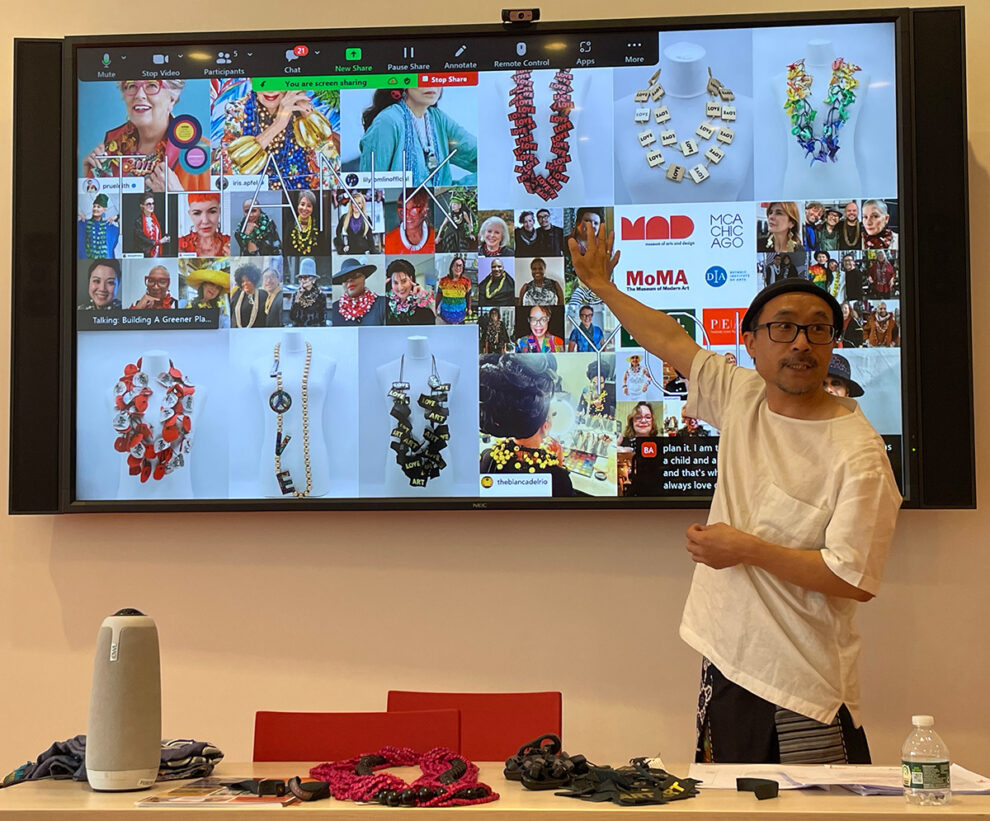Fashion may not be the first industry that comes to mind when discussing global sustainability, but the clothes we wear don’t just make an impression on the street; they leave their mark on the planet as well.
According to a recent report by Apparel Impact Institute, the fashion industry was responsible for about 2% of global greenhouse gas emissions in 2021. But fashion’s environmental impact isn’t limited to greenhouse gas emissions. Cotton production is water-intensive, textile dyeing and finishing contribute to global water pollution, and synthetic fabrics like polyester leach microplastics into oceans and other waters. The kicker? Some 85 percent of all textiles generated in the United States—about 14 million tons a year—end up being incinerated or in a landfill. And as the market for fast fashion continues to expand, carbon emissions from the fashion industry are projected to surge in coming years.

Jianhui Yan speaking at the “Building a Greener Planet” event.
Recognizing its outsize environmental impact, some suppliers, manufacturers, business leaders and consumers have begun to call for a more sustainable fashion industry. But for jewelry designer Jianhui Yan, sustainability isn’t a novel concern; it’s been a keystone of his work since he opened his first shop in London’s South Bank almost two decades ago.
Yan recently discussed his designs and vision in “Building a Greener Planet,” part of the Columbia Climate School’s roster of events for Climate Week 2023. In the interview below, I followed up with Yan to learn more about his work and what inspires his innovative approach to fashion.
Can you tell us a bit about your background? What influenced your design philosophy?
I was born and grew up in a small rural village during the Chinese Cultural Revolution. When I was a child and a teenager, I spent lots of time alone in the mountains. My love for plants, trees, flowers, birds and animals started then. I love nature and often get inspired by nature. So being kind to nature is always in my mind whenever I create my designs.
How did you get started in fashion design, and using recycled materials in your work?
In order to pay the debt for my MBA degree in England, I used to sell antiques and vintage stuff at Portobello and Spitalfields Markets in London. During that time, I started making necklaces with broken vintage pieces. From these early pieces to my recent Aqua Collection made from recycled plastic water bottles, I have been using recycled materials to create my eco-friendly designs for over 18 years. I believe the most sustainable materials are those we already have, and that sustainability is not a trend, but a mission which makes our planet greener.
I have used all kinds of recycled materials to make my designs. The Next Pashmina collection, made from recycled wood, was praised by Elio Fiorucci as “the most beautiful eco-friendly design.” My recycled leather collection won a sustainability award by NY NOW in 2020. And my latest collection, Love From My Father, is made from recycled newspaper with the word “love” hand written in Chinese by my father. It is loved by people from around the world.
How do you source materials for your work?
Most of the time, I get rubbish, or offcuts that would be thrown away, from workshops and factories. Sometimes I also buy leftovers from factories which are discontinuing a particular line or that have gone bankrupt. If I don’t use these materials, it’s very likely most of them will end up in landfills. But for me, each piece, no matter big or small, is either poison to our planet or us if we don’t use it, or precious if we choose to use it.
What are some of the key challenges on the path to a more sustainable fashion industry?
The biggest challenge is how to make fast fashion companies care less about profit and put more attention on the pollution caused by the fashion industry. The fashion industry must face the fact that it takes enormous energy to make new materials, and that it also has an enormous negative impact on our planet, both environmentally and socially. While they are doing their best to make a profit, they also should give themselves time to think about how future generations are going to live.
Do you feel that individual choices can make a difference when it comes to sustainability?
Yes, absolutely. To slow these problems down and make our planet greener requires everyone’s effort. Never underestimate the impact your daily life may have on our planet, both in good and bad ways.

Event attendees modeling sustainable fashion, including some of Yan’s designs.
In the West, we are richer than most other nations, so we consume much more. Especially when it comes to fast fashion—some people just buy, buy, buy. Every time I walk into a fast fashion store I see people with five to 10 pieces in their hands in the queue waiting to pay. How long will these pieces last? Some may last for a month, some may last for just a week. Some might be thrown away before they are even worn. To stop the climate crisis or slow it down and buy us more time, individuals have to act and work together. I believe in “together, stronger.”
Why is sustainability integral to your work? What inspires you to make sure your designs are as environmentally friendly as possible?
It’s personal. My colleague and I have many nephews and nieces, and grand-nephews and grand-nieces ranging from one to 25 years old. We love them. We want to make their futures safer and greener. Almost all the artisans we have been working with have young children or grandchildren, and we feel we have a responsibility to protect our planet for these younger generations.

Samples of Yan’s work.
We try to use as little energy as possible and recycle materials. We take every step with care, such as using candlelight instead of lighters to burn the edges of plastic petals after we hand cut them.
“Building a Greener Planet” was presented during Climate Week 2023 as part of the Columbia Climate School’s Diversity, Equity, Inclusion, Anti-Bias, Anti-racism, Accessibility, and Justice programming.
Source : news.climate.columbia.edu




























